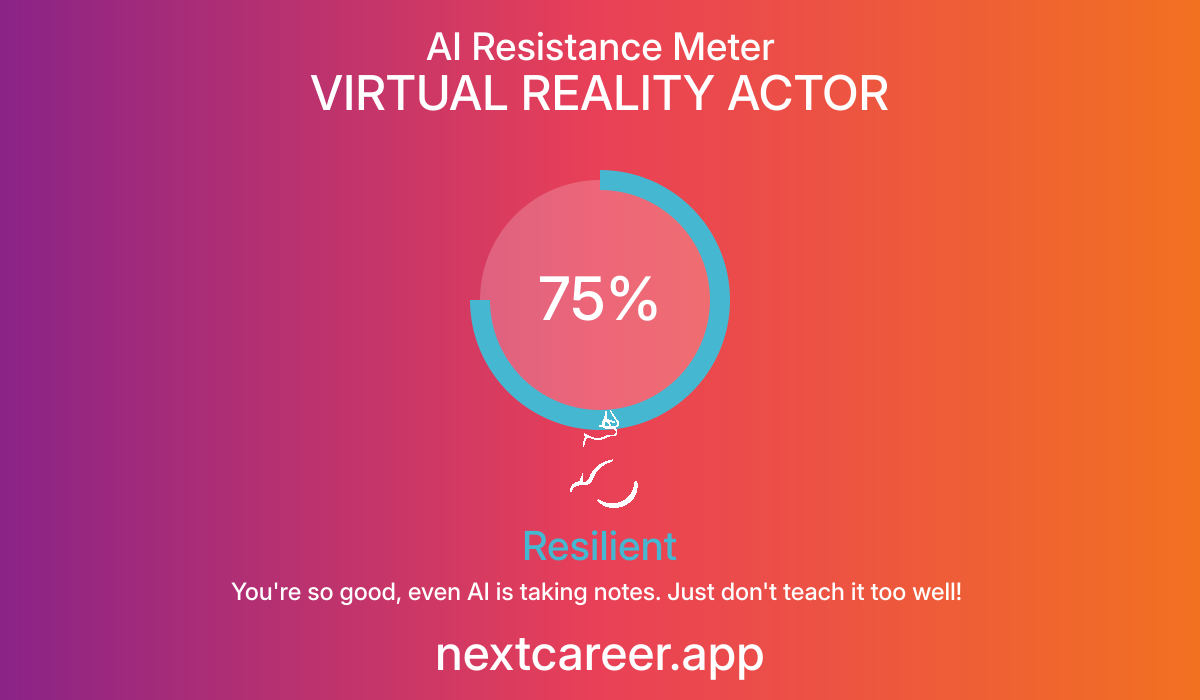AI Resistance Analysis
VIRTUAL REALITY ACTOR
VIRTUAL REALITY ACTOR
AI Resistance Score
AI Resistance Meter
Resilient
VIRTUAL REALITY ACTOR
You're so good, even AI is taking notes. Just don't teach it too well!
The role of a Virtual Reality Actor involves both cognitive and emotional skills that are essential for performance in immersive environments. While advancements in AI-generated virtual actors and environments are emerging, the unique human qualities of improvisation, emotional depth, and nuanced performance are challenging for AI models to replicate effectively. However, as AI technology continues to evolve, the role may integrate more human-AI collaboration, utilizing AI tools for enhanced storytelling or character development, rather than outright replacement.
The role of a Virtual Reality Actor involves both cognitive and emotional skills that are essential for performance in immersive environments. While advancements in AI-generated virtual actors and environments are emerging, the unique human qualities of improvisation, emotional depth, and nuanced performance are challenging for AI models to replicate effectively. However, as AI technology continues to evolve, the role may integrate more human-AI collaboration, utilizing AI tools for enhanced storytelling or character development, rather than outright replacement.
Key Factors
- Cognitive Tasks: AI can simulate scripts and perform tasks that require structured thinking, potentially reducing the need for some scripted performances.
- Emotional Intelligence: The ability to convey authentic emotions and connect with audiences on a personal level remains a human advantage.
- Physical Skills: While certain physical stunts can be digitally created or enhanced by AI, the presence of a physical actor can add authenticity to the experience.
- Creative Thinking: Originality and creativity in character portrayal, improvisation, and emotional nuance are inherently human traits that AI struggles to replicate.
Human Advantages
- Innate ability to improvise and respond to unpredictable scenarios in real-time.
- Emotional expression and authenticity can enhance audience engagement and experience.
AI Vulnerabilities
- AI-driven virtual actors could take over certain pre-defined roles or scenarios in VR environments, particularly in mass production settings.
- AI tools may lower the cost of entry for VR production, leading to increased competition.
Recommended Actions
- Focus on developing unique personal branding that emphasizes emotional intelligence and improvisational skills.
- Engage in continuous learning and training in AI and digital storytelling technologies to adapt and collaborate effectively with emerging tools.
- Build strong networking connections with VR production teams to explore diverse and innovative roles that augment traditional acting practices.
In the near term (5 years), as technology improves, we might see more collaborative tools developed, allowing VR actors to augment their performances with AI capabilities, perhaps in aspects like script generation or virtual set design. In the long term (20+ years), while some aspects of acting roles may see reduction due to AI advancements, the demand for human actors who can bring nuanced emotional layers and improvisational skills to complex narratives is likely to remain. The role may evolve to include more director-like responsibilities, where human actors guide AI systems while maintaining the emotional core of virtual experiences.

Why Calculate AI Resistance?
Understanding how AI-resistant your career is becoming increasingly important in today's rapidly evolving job market. Our analysis combines multiple factors including required human skills, technological adaptability, and future industry projections to give you a comprehensive view of your career's sustainability.